Puget Systems Echo: Intel and AMD Showdown at 65 Watts
by Dustin Sklavos on March 21, 2012 2:35 AM EST- Posted in
- Systems
- AMD
- Intel
- Mini ITX
- Sandy Bridge
- Llano
- boutique
- Mini-Tower
System Performance
When I started testing these two systems from Puget Systems I honestly wasn't prepared for the kind of tug of war that would occur. Fundamentally, the expected results are on the page: the Intel CPU outclasses the AMD APU at every turn, while AMD's integrated graphics hardware thoroughly outclasses Intel's. I'm not going to lie either, the results are about what you'd expect. What impressed me was just how wide the gaps were. Take a look.
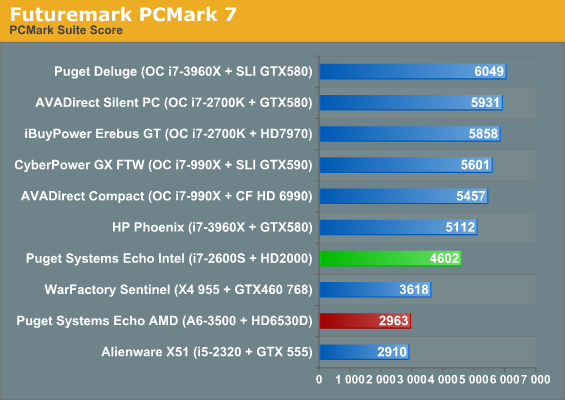
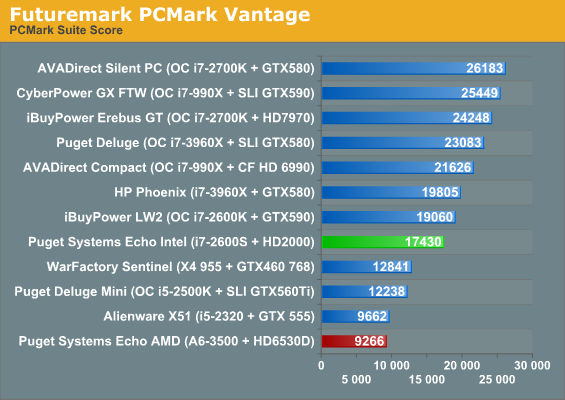
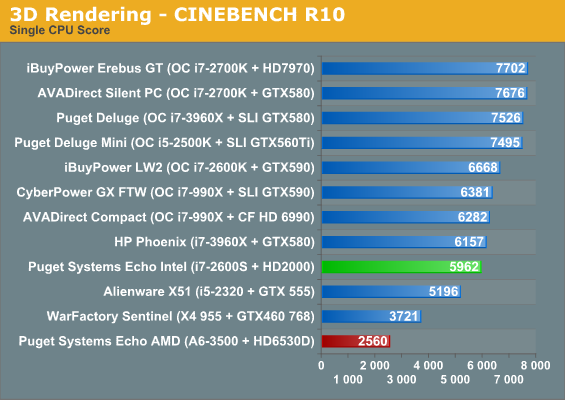
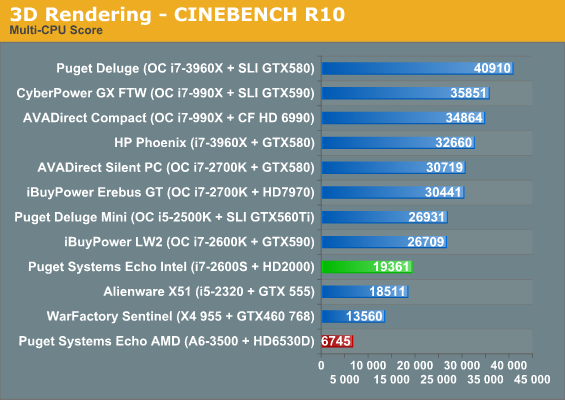


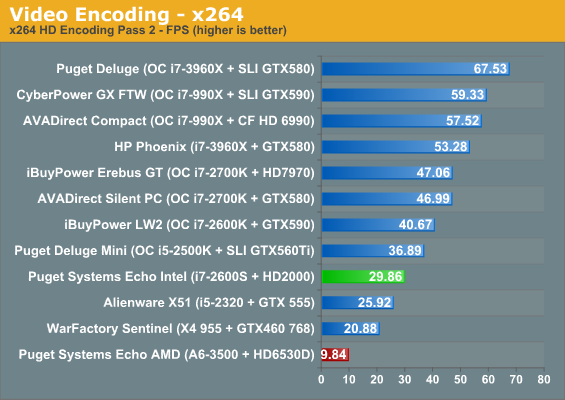
While the A6-3500's CPU performance would certainly be fine for a notebook, it's absolutely lousy on the desktop. Granted much of our competition is pretty unfair, with overclocked systems abounding, but look at how badly it even struggles against a last-generation Phenom II X4 955, much less the Intel Core i5-2320 in the Alienware X51. The i7-2600S is consistently two-to-three times faster in roughly the same power envelope.
To be fair, though, these results need to be framed in a more meaningful way than just "the A6-3500's CPU is dog slow." We need to consider the environments in which these systems are going to be used, and at the risk of sounding like an AMD apologist, I don't see many situations where the Intel chip's mammoth lead on the A6-3500 is going to be relevant. The A6-3500 is fine for basic Photoshop work, and neither of these systems are really ideal for serious video editing, where you need a much faster storage subsystem and CPU/GPU than either can provide either internally or externally.
Where a computer is much more likely to see frequent (if casual) use is in trying to run games, and here's where things take a turn.
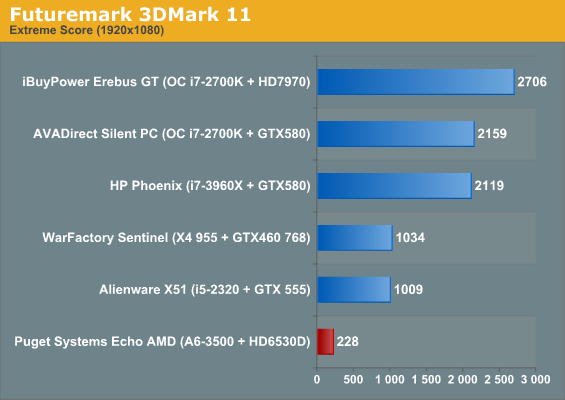


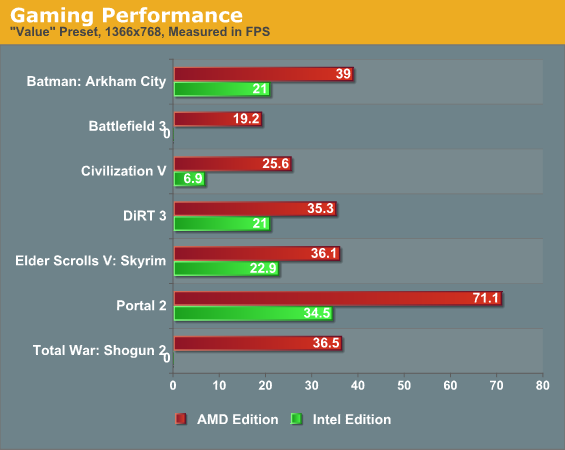
The Intel Core i7-2600S with its crippled IGP can't even run two of our benchmarks, and only produces playable performance in one of them: Portal 2, with its ancient (albeit updated) Source engine. Meanwhile, the Radeon HD 6530D inside the A6-3500 can stretch its legs and deliver playable performance across every game except Battlefield 3, where a dip in resolution or settings will render that game playable as well.
Granted, these are conservative settings at a relatively low resolution, but the point remains that if someone wants to play a game on the A6-3500, they can, and reasonably comfortably. I've seen someone suddenly decide they want to try and play a game only to discover their system's integrated graphics can't handle it at all, and forums are rife with threads of people asking how to upgrade the graphics of their cheap desktops or their notebooks being met with the same answer: "you're screwed." With larger desktop systems, it's a different matter, but for mini-ITX and laptops you have to be prepared to live with whatever graphics the system includes from the factory.










62 Comments
View All Comments
sabot00 - Wednesday, March 21, 2012 - link
A trip to the Wikipedia page for Llano http://en.wikipedia.org/wiki/AMD_Fusion#.22Llano.2...Shows that the A6-3500 is FAR, FAR from the best AMD has in the 65 W space.
The A6-3600 and A6-3620 deliver 4 cores at 2.1 and 2.2GHz (another whole core compared to the 3500)
Meanwhile, in the A8 it gets worse, the A8-3800 and 3820 deliver 4 cores at 2.4 and 2.5GHz WHILE ALSO giving the HD6550D (400 SP's, 80 more than the 3500).
Leaving AMD 1 core, 400 MHz, and 80 SP's down just feels wrong.
HW_mee - Wednesday, March 21, 2012 - link
1. This is Anandtech, what did you expect?2. Puget only sells the AMD system with an A4-3400 and the A6-3500.
Anandtech can only review pre-assembled systems as the systems are sold, the fact that Anandtech cares to compare such vastly different system is a different debate.
Arnulf - Wednesday, March 21, 2012 - link
Fine, but it woudl make sense to cobble together their own setup using the best components that still fit same thermal envelope (afteralkl a user might decide to upgrade !). This means fastest 65W APU and fastest memory that is supported by that CPU.HW_mee - Wednesday, March 21, 2012 - link
1st, let me mention that I love prebuild reviews, even when I don't have a chance of buying the reviewed system, but I find that this review is lacking or a bit odd.2nd, Adding a DIY system would be as awkward as the existing comparison, 1750$ prebuild Intel system vs 1400$ prebuild AMD system vs. DIY system with 65 watt CPU system?
I think Dustin has held a good scope by only looking at the top offerings for the Puget Systems Echo an he is very balanced in his praise of both systems.
Unfortunately I see no reason to compare performance of these systems, AMD will get a beating on the CPU side, again, and Intels horrible IGP is absent from half the test, again.
3rd, I have not read other Puget system reviews on anand, but I would have preferred the review had an extra page dedicated to the systems and reseller.
A large markup is mentioned, but an example of how cheap a DIY person can make it is not shown.
Build quality, noise, temperature etc. is leisurely mentioned but never with anything really tangible.
I could go on :-/
silverblue - Wednesday, March 21, 2012 - link
Yes, but there's time and there's money. In any case, judging by the power usage of the A6-3500 I think it's fair to assume that you can use one of the more powerful variants and still not get anywhere near the 100W ceiling (though I suppose, with the 3850, it'd get close - but we ARE talking the differences mentioned by sabot00 above plus the 157MHz higher GPU clock).djfourmoney - Thursday, April 12, 2012 - link
Read the reviews of the 3650 and you'll find under load (just the APU) it will exceed 100W. Under "Normal" use, however it might not see that.I don't think that would have helped much. I still don't understand if memory is so important to AMD's performance that they didn't put it inside their systems.
I smell something, as I said Tom's already did a test of several sticks of memory for APU's
djfourmoney - Thursday, April 12, 2012 - link
Only problem is finding a A6-3800 which is the Quad Core 65W. Missing Remote tested one, but I can't seem to find one here or in Europe and I haven't tried Asia yet.I already bought an A6-3500 though and since its an HTPC, it will be more than fine with 1600 speed memory and SSD like featured though smaller (64GB), so maybe with a slight OC and OC the memory I can smoke the benchmarks set here.
There is an A6-3860 which is the revision of the Quad Core but it seems those have all gone to OEM's now.
Guess this fight will continue when Trinity comes out and hopefully a low TDP Quad Core will be widely available.
Hrel - Wednesday, March 21, 2012 - link
If you guys read the entire article not only would you see some of what you've said here IN the article; but you would know WHY they tested the way they did.Dustin Sklavos - Wednesday, March 21, 2012 - link
This is a tired argument and something I've gotten really sick of seeing since I started writing here nearly two years ago. It's very easy to cry foul and scream bias without reading the entire article or thinking about why the material might seem the way it is.I will say this once to get it out of my system: nobody here is on anyone's payroll. There is no collective site bias. We report what we find. If you feel otherwise, so be it, but I was an AnandTech reader long before I started writing here and I can tell you I wouldn't have stuck around if things weren't honest.
MonkeyPaw - Wednesday, March 21, 2012 - link
I found the article valuable for what it was. Thanks.It was a shame they shipped the Llano build with DDR3 1333. As an owner of the A3850, even the jump to 1600 provides a fairly noticeable jump in gaming performance. Did the motherboard allow you to bump up the memory frequency? If not, I guess a decent option would be to get this system with the least amount of RAM possible and then buy 8GB of 1600 for $40 and install it yourself. :)